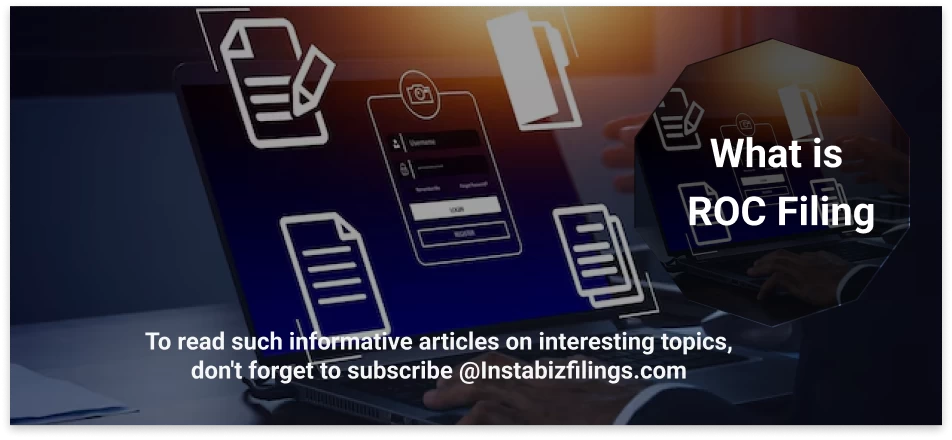
What is ROC Filing
October 25, 2024 by Team Instabizfilings
ROC filing refers to submission of information, which is filed on statutory basis to the Registrar of Companies. The Registrar of Companies (ROC) operates under the Ministry of Company Affairs (MCA) in India. These filings are mandated under the existing laws applicable to companies and Limited Liability Partnerships (LLPs) where the filings are done for various purposes in order to provide transparency and protect the stakeholder’s interest.
Here remains a comprehensive guide on ROC Filing:
What is ROC Filing?
ROC filing is a legal process in which every company and LLPs incorporated in India need to submit documents on an annual basis or at regular intervals with the Registrar of Companies. Some of these filings include; Annual and quarterly returns, financial statements, details on shareholders’ information, directors and statutory returns.
Types of ROC Filings
ROC filings are of different types and depending on the structure and operations of the company they have to file a particular form. Some of the key filings include:
(a) Annual ROC Filings:
-
Form MGT-7 (Annual Return): This form gives information on the proportional ownership of the company and change of directors and the performance of the company in the previous financial year.
-
Form AOC-4 (Financial Statements): A company is expected to produce a balance sheet, profit and loss account, and other financial statements. For audited companies, the auditor’s report and consolidated financial statements, if any are also filed along with this form.
-
Form ADT-1 (Appointment of Auditor): It is used to notify the ROC with the appointment or reappointment of the company’s auditor.
-
Form MGT-8: Certification of the annual return for certain companies (depending on size, turnover etc.) by the company secretary whilst in practice.
(b) Event-Based ROC Filings:
These are documents that are made in relation to certain activities undertaken by companies or occurrences such as:
-
Form DIR-12 (Changes in Directors): Filed when there is a change in the Company’s directors for instance - appointment, resignation etc.
-
Form SH-7 (Change in Share Capital): Filed any time the company changes its capital structure as embodied in the authorized share capital of the company.
-
Form PAS-3 (Allotment of Shares): Filed when there is any further issue or allotment of new shares.
-
Form INC-22 (Change in Registered Office): Filed when the company has or moves to a new registered office.
-
Form CHG-1/CHG-4 (Creation/Modification/Satisfaction of Charges): Filed when the company borrows money by mortgaging the assets (creation) or pays off a loan (satisfaction).
For whom ROC Returns needs to be filed?
-
Private Limited Companies: These are required to file yearly returns and financial statements regardless of their size or turnover.
-
Public Limited Companies: New or additional conditions for filing a ROC due to change of control of the corporation as a result of a public company.
-
One Person Companies (OPC): Had to lodge annual returns and directors’ financial statements.
-
Limited Liability Partnerships (LLPs): LLPs need to complete and submit Form 11 (Annual Return) and Form 8 (Statement of Accounts & Solvency) within the year.
Due Dates for ROC Filings
-
Form MGT-7: The other reports must be made within 60 days from the date of the Annual General Meeting.
-
Form AOC-4: These are to be submitted within 30 days of the date of the AGM.
-
Form ADT-1: Filing must be done within the first 15 days that the auditor takes the office.
-
LLP Annual Filing:
-
Form 11: Are required to be submitted before May 30 of every financial year.
-
Form 8: Submissions to be made at the end of the financial year not later than October 30 each year.
Penalties for Late or Non Filing
If a company or an LLP does not file the ROC returns on due dates, the following may occur:
-
Penalties and Additional Fees: Additional charges are imposed on businesses that do not submit the documents before or by the specified dates. These fees can build upon the time taken (up to ₹100 per day for each form).
-
Disqualification of Directors: In case ofnon-submission of financial statements or annual returns may result in disqualification of directors.
-
Striking Off: In more serious cases of non compliance the ROC can remove the name of the company from the register and the company is deregistered.
Overview of ROC Forms
ROC filing could be done online through the portal of MCA. The key steps are:
-
Preparation of Documents: Preparation of balance sheet, profit statement, equity holding and register of directors are required.
-
Login to the MCA Portal: An authorized person which could be a director or a company secretary has to use his Digital Signature Certificate.
-
Filling Out Forms: The necessary particulars are to be reported in the related details (including MGT-7, AOC-4, etc.).
-
Submission and Payment: Once all the forms have been completed, they are forwarded online and the ROC fees (and, optionally, the late fees) are paid online.
-
Acknowledgment: Upon the submission, an acknowledgment is created indicating acknowledgement of filing of the form.
Documents needed for ROC filing
Different documents have to be attached according to the particular form, which has to be filled in. Commonly required documents include:
-
The Balance sheet is in part of the simplified financial statement, this is followed by the Profit & Loss Account.
-
Corporation Shareholders and Directors List
-
Auditor’s Report.
-
Director’s Report.
-
Board Resolutions (in case of some event based filings).
ROC Compliance for Various Entities
Every type of the entity will have a different ROC filing and compliance to do. For instance:
-
Private Limited Companies: Annual filing of MGT-7 and AOC-4 online.
-
LLPs: Annual Return Form 11 & Financial Statements Form 8.
Conclusion
ROC filings are very much relevant to organisations and are compulsory for every single registered organisation in India. Non compliance results in penalties, director penalizations, and sometimes the striking off the company. Timely and proper filing contributes towards keeping your company upright in the eyes of the law.
Disclaimer
The information provided in this blog is purely for general informational purposes only. While every effort has been made to ensure the accuracy, reliability and completeness of the content presented, we make no representations or warranties of any kind, express or implied, for the same.
We expressly disclaim any and all liability for any loss, damage or injury arising from or in connection with the use of or reliance on this information. This includes, but is not limited to, any direct, indirect, incidental, consequential or punitive damage.
Further, we reserve the right to make changes to the content at any time without prior notice. For specific advice tailored to your situation, we request you to get in touch with us.


